Producten
-

Waveshare Waveshare Solar Power Manager (C)
De Solar Power Manager is compatibel met standaard 6 ~ 24 V zonnepanelen. Hij kan de 18650 oplaadbare Li-ion accu’s opladen via een zonnepaneel of een USB-C aansluiting, en biedt een gestabiliseerde uitgang van 5 V / 3 A (met ondersteuning voor meerdere protocollen, waaronder PD/QC/FCP/PE/SFCP).De module beschikt over een MPPT (Maximum Power Point Tracking) functie en meerdere beveiligingscircuits, en werkt daarom veilig en met hoge efficiëntie en stabiliteit. Hij is geschikt voor IoT op zonne-energie, toepassingen op laag vermogen en andere energiezuinige projecten.Kenmerken Ondersteunt MPPT (Maximum Power Point Tracking), waardoor de efficiëntie van het zonnepaneel wordt gemaximaliseerd Flexibel accu’s opladen: van zonnepaneel of USB-C voedingsadapter Compatibel met 6 ~ 24 V zonnepanelen, DC-002 jack ingang of schroefaansluiting Een ingebouwde MPPT SET-schakelaar, waarmee u het niveau selecteert wat het dichtst bij het ingangsniveau ligt om de laadefficiëntie te verbeteren Een ingebouwde aluminium elektrolytische condensator met hoge capaciteit en een SMD keramische condensator, waardoor de rimpelspanning wordt verminderd, en voor een stabiele werking Een ingebouwde accuhouder, geschikt voor 3x 18650 oplaadbare Li-ion accu’s Verschillende led-indicatoren, voor het monitoren van het zonnepaneel en de accu’s Meerdere beveiligingscircuits: over-laden / over-ontladen / bescherming tegen omgekeerd aansluiten / oververhitting / teveel stroom, voor een stabiele werking en veilig gebruik Specificaties Zonnecel ingang 6~24 V (default 18 V) Opladen USB Accu 3x 18650 Li-ion accu’s (NIET inbegrepen) USB-ingang 5 V (USB-C, met PD quick charge ondersteuning) 5 V uitgang 5 V / 3 A (USB-OUT, USB-C) Cutoff spanning bij opladen 4,2 V ±1% Over-ontladen beschermingsspanning 3.0 V ±1% Zonnepaneel oplaad efficiency ~78% USB oplaad efficiency ~93% Accu boost output efficiency ~90% Ruststroom (max) <2 mA Behuizing Metalen behuizing Bedrijfstemperatuur -40°C ~ 85°C Afmetingen 119,0 x 71,0 x 25,2 mm Inbegrepen 1x Solar Power Manager (C) 1x Adapter DownloadsWiki
-
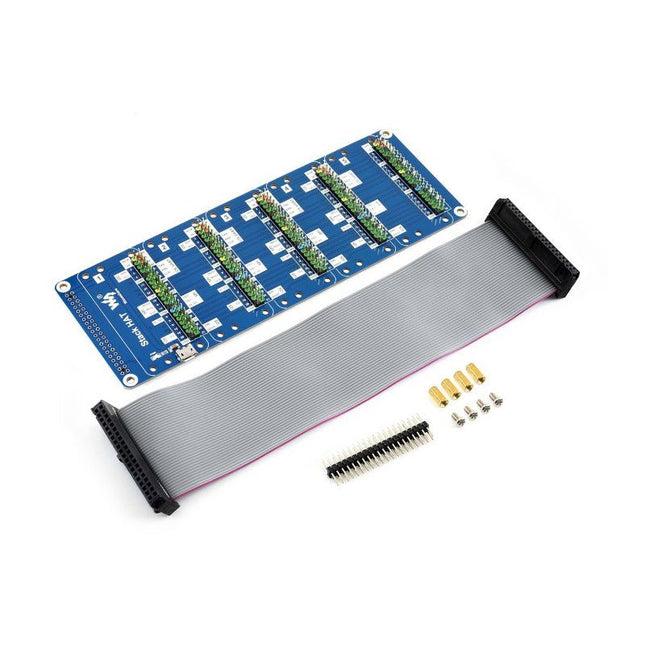
Waveshare Waveshare Stack HAT for Raspberry Pi
This is an I/O expansion kit designed for Raspberry Pi, which provides 5 sets of 2x20 pinheaders, that means a handy way to 'stack' multi different HATs together, and use them as a specific combination / project. Features Standard Raspberry Pi connectivity, directly pluggable OR through ribbon cable 5 sets of 2x20 pinheaders, connect multi HATs together USB external power port, provides enough power supply for multi HATs Clear and descriptive pin labels for easy use Reserved jumper pads on the bottom side, pin connections are changeable by soldering, to avoid pin conflicts Note: make sure there are no any pin conflicts between the HATs you want to use together before connecting. Specifications Dimensions: 183 × 65 mm Mounting hole size: 3 mm Included 1x Stack HAT 1x Ribbon cable 40-Pin 1x 2x20 male pinheader 1x RPi screws pack (4pcs) x1
€ 17,95
Leden € 16,16
-

WCH WCH CH32V307V-EVT-R1 RISC-V Development Board
WCH CH32V307 RISC-V development board features 8 UART ports controlled over Ethernet The CH32V307 is an interconnected microcontroller, based on 32-bit RISC-V core, with hardware stack area and fast interrupt entry. Compared with standard RISC-V, the interrupt response speed is greatly improved. With single-precision float point instruction sets added and stack area extended, the CH32V307 has higher performance, the number of U(S)ART is extended to 8, and the number of motor timer is extended to 4. The CH32V307 provides USB2.0 high-speed interface (480 Mbps) and has built-in PHY transceiver. Ethernet MAC is upgraded to GbE and integrates 10M PHY module. Features RISC-V4F processor, max 144 MHz system clock frequency Single-cycle multiplication and hardware division, hardware float point unit (FPU) 64KB SRAM, 256 KB Flash Supply voltage: 2.5 V/3.3 V, GPIO unit is supplied independently Multiple low-power modes: sleep/stop/standby Power-on/power-down reset (POR/PDR), programmable voltage detector (PVD) 2 general DMA controllers, 18 channels in total 4 amplifiers Single true random number generator (TRNG) 2x 12-bit DAC 2-unit 16-channel 12-bit ADC, 16-channel TouchKey 10 timers USB2.0 full-speed OTG interface USB2.0 high-speed host/device interface (built-in 480 Mbps PHY) 3 USARTs, 5 UARTs 2 CAN interfaces (2.0B active) SDIO interface, FSMC interface, DVP 2x I²C, 3x SPI, 2x I²S 80 I/O ports, can be mapped to 16 external interrupts CRC calculation unit, 96-bit unique chip ID Serial 2-wire debug interface Packages: LQFP64M, LQFP100 Downloads Datasheet GitHub
-
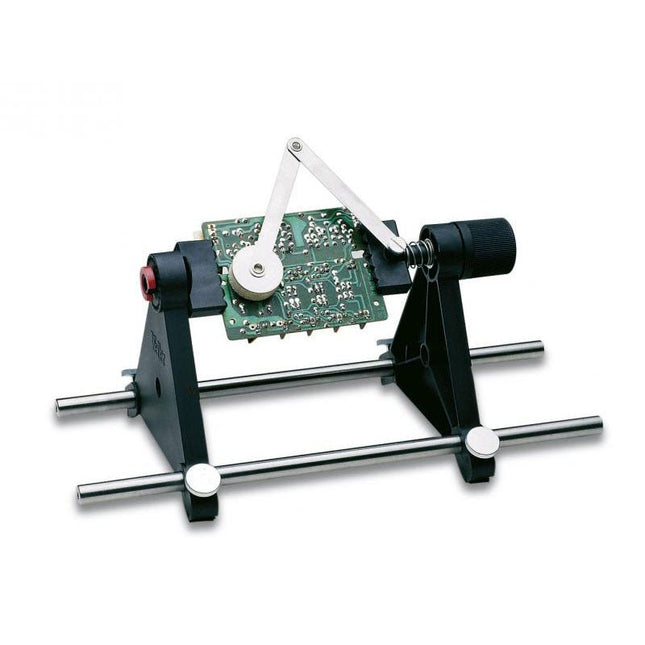
Weller Weller ESF 120ESD PCB-houder
Met de Weller ESF 120ESD PCB-houder fixeert u uw printplaat zonder de noodzaak voor extra benodigdheden of gereedschap. Het frame heeft een veermechanisme en kan 360° om zijn as draaien in stapjes van 15°. De druk-arm is voorzien van een druksysteem om de componenten op hun plaats te houden wanneer de PCB gedraaid wordt voor het solderen. Eigenschappen: Maximale printgrootte 160 x 235 mm Draait 360° in stappen van 15° Klem met veersysteem Druk-arm voor het fixeren van componenten ESD-veilig
-

Weller Weller WLACCHHM-02 PCB Holder with 4 Magnetic Arms
Free up your hands and secure and protect your soldering projects with Weller's Helping Hands with 4 Magnetic Arms. Enjoy adjustable and flexible positions with magnetic gooseneck arms with alligator clamps that are easily positionable for multiple configurations. Applications Hobby Home repair Drone Audio repair Joining wires Engraving Jewelry making Electronics Specifications Dimensions (Base) 152 x 229 mm (6 x 9') Length (Arms) 2 arms: 216 mm (8.5')2 arms: 317 mm (12.5')
-
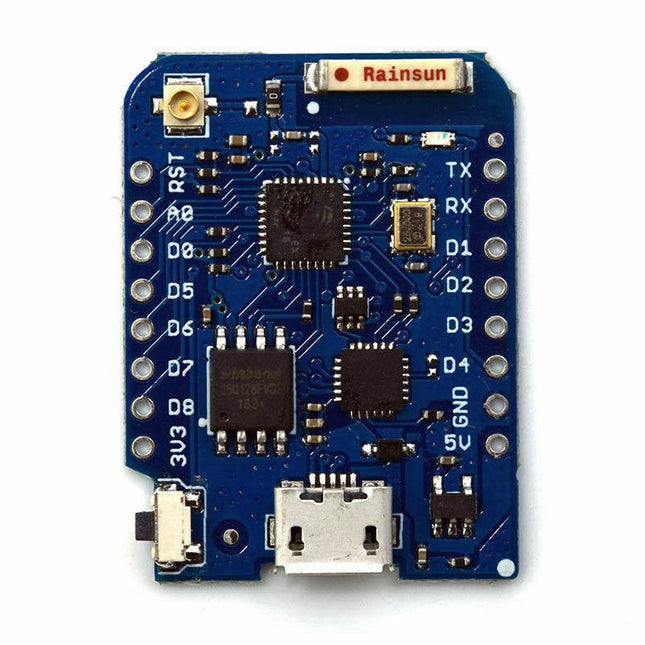
Wemos WeMos D1 mini Pro ESP8266 based WiFi Module
This mini WiFi board has 16 MB flash, external antenna connector and built-in ceramic antenna based on ESP8266EX. Features 11 digital input/output pins Interrupt/pwm/I²C/one-wire 1 analog input (3.2 V max input) 16 MB Flash External antenna connector Built-in ceramic antenna CP2104 USB-TO-UART IC Specifications Operating Voltage 3.3 V Digital I/O Pins 11 Analog Input Pins 1 (3.2 V max) Clock Speed 80/160 MHz Flash 16 MB Size 34.2 x 25.6 mm Weight 3 g Pin Configuration Pin Function ESP8266 Pin RX RXD RXD A0 Analog input, max 3.2 V A0 D0 IO GPIO16 D1 IO, SCL GPIO5 D2 IO, SDA GPIO4 D3 IO, 10k Pull-up GPIO0 D4 IO, 10k Pull-up, BUILTIN_LED GPIO2 D5 IO, SCK GPIO14 D6 IO, MISO GPIO12 D7 IO, MOSI GPIO13 D8 IO, 10k Pull-down, SS GPIO15 G Ground GND 5V 5 V - 3V3 3.3 V 3.3 V RST Reset RST Included 1x WeMos D1 mini Pro (based on ESP8266EX) 2x Pin header (short) 2x Female connector strip (short) 2x Female connector strip (long)
€ 14,95
Leden € 13,46
-

Velleman Whadda Brain Game
4 LEDs and 4 push buttons ensure hours of fun. Repeat the combination, harder and harder, faster and faster. The microprocessor-controlled game has 4 different difficulty levels and low consumption. The sound and/or LED indication are adjustable. To save the three 1.5 V AA batteries (not included), the kit automatically switches itself off when not in use. Downloads Manual
€ 11,95
Leden € 10,76
-

Velleman Whadda E-12 Series Resistor Set (610 pcs)
The Whadda E12 is a high-quality carbon film resistor set comprising 610 pieces, with 10 pieces for each of the 61 standard E12 series values ranging from 10 Ω to 1 MΩ. Each resistor has a power rating of 0.25 W, a tolerance of 5%, and can operate within a temperature range of -55°C to 155°C. The maximum operating voltage is 250 V. These resistors are suitable for applications in TVs, audio and video equipment, telephone receivers, communication systems, instrumentation, and home appliances.
€ 11,95
Leden € 10,76
-

Velleman Whadda Electronic Christmas Tree
The Christmas tree with flashing LEDs takes the coziness of Christmas to a new level! With 16 flashing LEDs, this green Christmas tree creates a warm atmosphere. With very low power consumption and the option to be powered by a 9-volt battery (not included), this Christmas decoration is easy to use. Enjoy the holidays with this atmospheric addition to your decoration collection. Downloads Manual
€ 9,95
Leden € 8,96
-
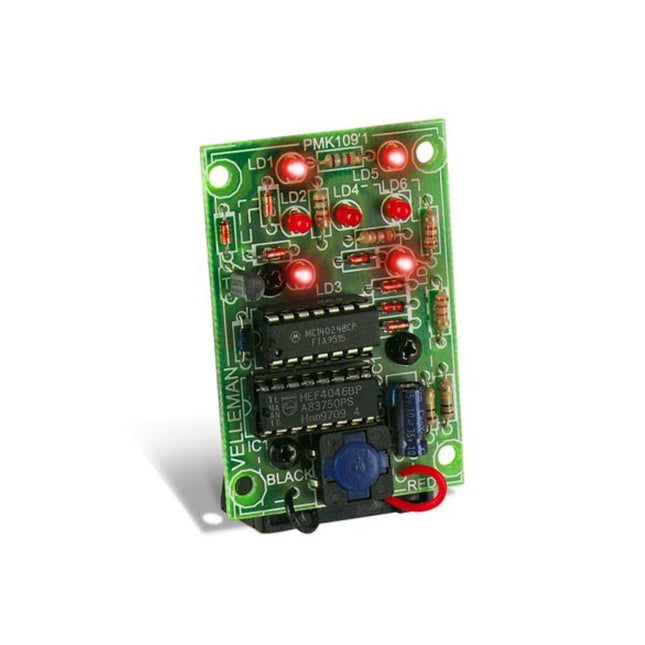
Velleman Whadda Electronic Dice
This electronic dice with 7 red LEDs rolls when the push button is released and works with a 9 V battery (not included). Downloads Manual
€ 9,95
Leden € 8,96
-

Velleman Whadda Beating Heart
Valentine's Hearts, 28 blinking LEDs, romantic LED lighting Valentine's Hearts – 28 blinking LEDs for a romantic atmosphere. The perfect Valentine's gift to express your love. Battery-powered and portable, ideal for Valentine's Day. Downloads Manual
€ 11,95
Leden € 10,76
-

Velleman Whadda Flashing LEDs Soldering Kit
This educational soldering kit is suitable for all kinds of applications such as model making and works with a 9 V battery (not included). You can control the flashing speed with two potentiometers. Downloads Manual
€ 8,95
Leden € 8,06
-

Velleman Whadda Madlab Electronic Kit (Junior Theremin)
The Theremin was the first music synthesizer. The Junior Theremin is our, smaller, version of that classic electronic musical instrument. As you move your hand towards and away from the wire aerial, the Theremin responds by changing the pitch of the note it is playing. It can play individual notes as well as varying the tone of a single note. How do you use the theremin? The wire aerial responds to the movement of your hand towards and away from it and changes the pitch of the note it plays, without actually being touched. Junior Theremin works in two modes – continuous and discrete. When you first connect the battery Junior Theremin is in continuous mode. Pressing both pushbuttons together switches between continuous and discrete modes. Discrete mode, as its name implies, plays individual or discrete notes rather than a continuously variable tone. Eight notes over a single octave are available. In discrete mode the two pushbuttons change the octave of the notes. The left-hand pushbutton (marked -) lowers the octave, and the right-hand pushbutton (marked +) raises the octave. The pushbuttons only change the octave so long as they are pressed. In continuous mode the pushbuttons have no effect. Downloads Manual
€ 12,95
Leden € 11,66
-

Velleman Whadda Shaking Dice
When playing a board game, do you find it annoying when you push away all the pawns with the dice? Or when friends try to cheat by manipulating the dice? With this soldering kit, this is a thing of the past. Instead of pressing a button, you activate this microprocessor-controlled dice by shaking. The 7 flashing LEDs run out slowly and the final combination is displayed flashing. The kit works with one CR2025 or one CR2032 button cell (not included). Downloads Manual
€ 14,95
Leden € 13,46
-

Velleman Whadda WSPXL103 Poly Rendier XL Soldeer- en programmeerkit (incl. Arduino Nano Every)
Op zoek naar een leuk zelfbouw project voor Kerst? Zet dit extra grote Poly Rendier beeldje in elkaar en programmeer het en laat de LED's alle kleuren van de regenboog weergeven! Ideaal voor zowel beginners als gevorderde makers!Deze leerzame en leuke bouwkit combineert soldeer- en programmeervaardigheden in één project van groot formaat. Eerst moet je enkele eenvoudige componenten op de verkoperde printplaat solderen. De componenten omvatten fraaie RGB LED's die een speciaal diffuus effect hebben. Als het soldeerwerk klaar is, kun je de kleuren en lichteffecten van de verschillende LED's programmeren dankzij de Arduino Nano Every. De Arduino wordt voorgeprogrammeerd met enkele basis LED-effecten, zodat je kit werkt zodra je hem van voeding voorziet met de meegeleverde adapter. Of je kunt ervoor kiezen je eigen code te schrijven op basis van de beschikbare voorbeeldcode.Programmeerbare uitbreidingenDe printplaat van dit project is speciaal ontworpen zodat je verschillende uitbreidingen kunt toevoegen. Voeg bijvoorbeeld een OLED-scherm toe om berichten weer te geven of programmeer het om de dagen tot Kerstmis af te tellen! Of voeg een IoT Tuya chip toe zodat je project kan communiceren met je smartphone. Je kunt zelfs een microfoon voor geluid, bewegingssensor of lichtsensor toevoegen.Kenmerken XL-formaat & verkoperde printplaat (PCB) in de vorm van een polymetrisch rendier 22 adresseerbare (programmeerbare) RGB LED's 14 x 5 mm RGB LED's 10 x 8 mm RGB LED's Arduino Nano Every Onboard drukknop USB A naar USB micro kabel voor programmering USB A naar USB B kabel voor voeding Houten houder Volledige handleiding en video beschikbaar in 5 talen Voorbeeldcode voor Arduino beschikbaar Leerzaam en leuk voor alle leeftijden en vaardigheidsniveaus Diverse uitbreidingen beschikbaar een OLED-scherm een slimme IoT-sensor om verbinding te maken met je smartphone een microfoonsensor en nog veel meer! Niet inbegrepen: soldeerbout, soldeertin, tang en een soldeermatje Specificaties Afmetingen: 168 x 270 mm Voeding: 5 V/2.1 A max. (kabel inbegrepen)
€ 54,95€ 29,95
Leden identiek
-

Velleman Whadda WTS100 Soldering Starter Set
Get ready to start soldering kits thanks to this all-inclusive tool set!Want to start soldering gadgets, or do you want to fix some home appliances, but you don't know what tools to get? Then this is the perfect set for you! It includes all the basic tools and practical necessities to start your journey as an electronics engineer or maker!Included AS19: Silicone soldering mat (350 x 250 mm) Lead-free solder Sn 99.3% – Cu 0.7% with dispenser (1.0 mm, 15 g) Desolder: Desoldering braid Stand20: Universal soldering iron stand VT281: Side cutter pliers VTD7: Powerful desoldering pump VTHHN: Helping hand with magnifier VTSI30C: High-Q ceramic soldering iron 30 W / 220-240 VAC
-

Elektor Publishing Wireless Power Design
From Theory to Practical Applications in Wireless Energy Transfer and Harvesting Wireless power transmission has gained significant global interest, particularly with the rise of electric vehicles and the Internet of Things (IoT). It’s a technology that allows the transfer of electricity without physical connections, offering solutions for everything from powering small devices over short distances to long-range energy transmission for more complex systems. Wireless Power Design provides a balanced mix of theoretical knowledge and practical insights, helping you explore the potential of wireless energy transfer and harvesting technologies. The book presents a series of hands-on projects that cover various aspects of wireless power systems, each accompanied by detailed explanations and parameter listings. The following five projects guide you through key areas of wireless power: Project 1: Wireless Powering of Advanced IoT Devices Project 2: Wireless Powered Devices on the Frontline – The Future and Challenges Project 3: Wireless Powering of Devices Using Inductive Technology Project 4: Wireless Power Transmission for IoT Devices Project 5: Charging Robot Crawler Inside the Pipeline These projects explore different aspects of wireless power, from inductive charging to wireless energy transmission, offering practical solutions for real-world applications. The book includes projects that use simulation tools like CST Microwave Studio and Keysight ADS for design and analysis, with a focus on practical design considerations and real-world implementation techniques.
€ 39,95€ 32,95
Leden identiek
-

Elektor Digital Wireless Power Design (E-book)
From Theory to Practical Applications in Wireless Energy Transfer and Harvesting Wireless power transmission has gained significant global interest, particularly with the rise of electric vehicles and the Internet of Things (IoT). It’s a technology that allows the transfer of electricity without physical connections, offering solutions for everything from powering small devices over short distances to long-range energy transmission for more complex systems. Wireless Power Design provides a balanced mix of theoretical knowledge and practical insights, helping you explore the potential of wireless energy transfer and harvesting technologies. The book presents a series of hands-on projects that cover various aspects of wireless power systems, each accompanied by detailed explanations and parameter listings. The following five projects guide you through key areas of wireless power: Project 1: Wireless Powering of Advanced IoT Devices Project 2: Wireless Powered Devices on the Frontline – The Future and Challenges Project 3: Wireless Powering of Devices Using Inductive Technology Project 4: Wireless Power Transmission for IoT Devices Project 5: Charging Robot Crawler Inside the Pipeline These projects explore different aspects of wireless power, from inductive charging to wireless energy transmission, offering practical solutions for real-world applications. The book includes projects that use simulation tools like CST Microwave Studio and Keysight ADS for design and analysis, with a focus on practical design considerations and real-world implementation techniques.
€ 32,95
Leden € 26,36
-
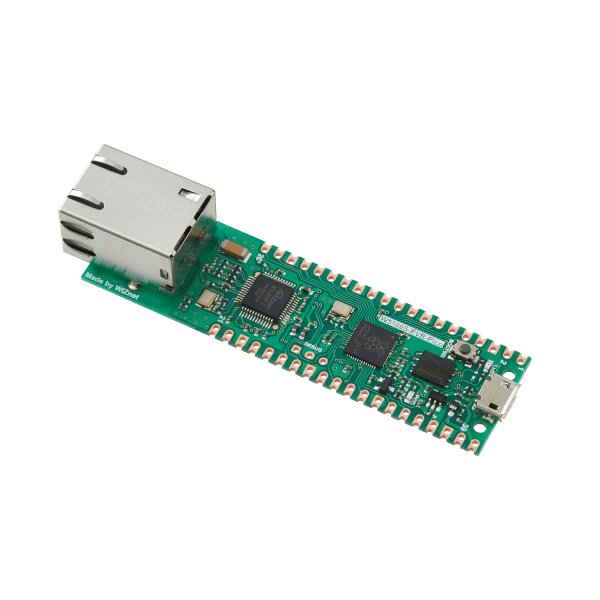
WIZnet WIZnet W5100S-EVB-Pico RP2040-based Evaluation Board
Features RP2040 microcontroller with 2 MB Flash Dual-core cortex M0+ at up to 133 MHz 264 KB multi-bank high performance SRAM External Quad-SPI Flash with eXecute In Place (XIP) High performance full-crossbar bus fabric 30 multi-function General Purpose IO (4 can be used for ADC) 1.8-3.3 V IO Voltage (NOTE. Pico IO voltage is fixed at 3.3 V) 12-bit 500 ksps Analogue to Digital Converter (ADC) Various digital peripherals 2× UART, 2× I²C, 2× SPI, 16× PWM channels 1× Timer with 4 alarms, 1× Real Time Counter 2× Programmable IO (PIO) blocks, 8 state machines total Flexible, user-programmable high-speed IO Can emulate interfaces such as SD Card and VGA Includes W5100S Supports Hardwired Internet Protocols: TCP, UDP, WOL over UDP, ICMP, IGMPv1/v2, IPv4, ARP, PPPoE Supports 4 Independent Hardware SOCKETs simultaneously Internal 16 KB Memory for TX/ RX Buffers SPI Interface Micro-USB B port for power and data (and for reprogramming the Flash) 40 pin 21x51 'DIP' style 1mm thick PCB with 0.1' through-hole pins also with edge castellations 3-pin ARM Serial Wire Debug (SWD) port 10 / 100 Ethernet PHY embedded Supports Auto Negotiation Full / Half Duplex 10 / 100 Based Built-in RJ45 (RB1-125BAG1A) Built-in LDO (LM8805SF5-33V) Downloads RP2040 Datasheet W5100S Datasheet Schematic & Part list & Gerber File C/C++ Examples CircuitPython Examples
€ 14,95
Leden € 13,46
-

WIZnet WIZnet W6100-EVB-Pico
W6100-EVB-Pico is een microcontroller evaluatiebord op basis van de Raspberry Pi RP2040 en een volledig geïntegreerde W6100 TCP/IP-controller, en werkt in principe hetzelfde als een Raspberry Pi Pico bord, maar met extra Ethernet via de W6100. Kenmerken RP2040 microcontroller met 2 MByte Flash Dual-core cortex M0+ tot 133 MHz 264 kByte multi-bank high performance SRAM Externe Quad-SPI Flash met eXecute In Place (XIP) High performance full-crossbar bus fabric 30 multifunctionele General Purpose I/O-poorten (4 daarvan te gebruiken voor ADC) 1,8 - 3,3 V I/O-spanning (note: de Pico I/O-spanning is vastgesteld op 3,3 V ) 12-bits 500 ksps Analoog naar Digitaal Converter (ADC) Diverse digitale randapparatuur: 2x UART, 2x I²C, 2x SPI, 16x PWM kanalen 1x Timer met 4 alarmen, 1x Real Time Counter 2x Programmable IO (PIO) blokken, 8 state machines totaal Flexibele, door de gebruiker te programmeren high-speed I/O Kan interfaces zoals een SD-kaart en VGA emuleren Ingebouwde W6100 Ondersteunt internetprotocollen: TCP, UDP, IPv6, IPv4, ICMPv6, ICMPv4, IGMP, MLDv1, ARP, PPPoE Ondersteunt gelijktijdig 8 onafhankelijke SOCKETs met 32 KB geheugen Intern geheugen van 16 Kbytes voor TX/RX buffers SPI interface Micro-USB B aansluiting voor voeding en data (en voor het herprogrammeren van de Flash) 40-pins 21x51 'DIP' stijl 1 mm dikke PCB met 0,1' through-hole pinnen met castellatie 3-pins ARM Serial Wire Debug (SWD) poort 10/100 Ethernet PHY embedded Ondersteunt Auto Negotiation Full / Half Duplex 10 / 100 gebaseerd Ingebouwde RJ45 (RB1-125BAG1A) Ingebouwde LDO (LM8805SF5-33V) Downloads Documenten Getting started on GitHub Firmware
€ 21,95
Leden € 19,76
-

WIZnet WIZnet WizFi360-EVB-Pico
Raspberry Pi Pico EVB combined with the WizFi360-PAWizFi360-EVB-Pico is based on Raspberry Pi RP2040 and adds Wi-Fi connectivity using WizFi360. It is pin-compatible with Raspberry Pi Pico board and can be used for IoT Solution development.Specifications RP2040 microcontroller with 2 MByte Flash Dual-core cortex M0+ at up to 133 MHz 264 kByte multi-bank high performance SRAM External Quad-SPI Flash with eXecute In Place (XIP) Includes WizFi360-PA Supports Hardwired Internet Protocols: TCP, UDP, WOL over UDP, ICMP, IGMPv1/v2, IPv4, ARP, PPPoE WiFi 2.4G, 802.11 b/g/n Support Station / SoftAP / SoftAP+Station operation modes Support “Data pass-through” and “AT command data transfer” mode Support serial AT command configuration Support TCP Server / TCP Client / UDP operating mode Support configuration of operating channel 0 ~ 13 Support auto 20 MHz / 40 MHz bandwidth Support WPA_PSK / WPA2_PSK encryption Support built-in unique MAC address and user configurable Industrial grade (operating temperature range: -40°C ~ 85°C) CE, FCC certification Includes 16 Mbit Flash Memory Micro-USB B port for power and data (and for reprogramming the Flash) 40 pin 21×51 ‘DIP’ style 1mm thick PCB with 0.1' through-hole pins also with edge castellations 3-pin ARM Serial Wire Debug (SWD) port Built-in LDO DownloadsDocumentation
€ 12,95
Leden € 11,66
-

YDLIDAR YDLIDAR G4 Lidar 360-degree Laser Range Scanner (16 m)
Na het inschakelen begint de YDLIDAR G4 met het roteren en scannen van de omliggende omgeving. De scanafstand is 16 m, en het apparaat hanteert daarbij een scansnelheid van 9.000 keer per seconde. Hij analyseert zorgvuldig zijn omgeving en kan daarin de kleinste objecten detecteren. Doordat zijn uiterst nauwkeurige borstelloze motor en encoder disc is gemonteerd op lagers draait hij erg soepel, en heeft hij een levensduur van maximaal 500.000 bedrijfsuren. De G4 is een goedkope oplossing voor projecten waarbij obstakeldetectie, obstakelvermijding en/of simultaneous localization and mapping (SLAM) vereist is. Alle YDLIDAR producten zijn ROS ready. Kenmerken 360 graden 2D range scanner Stabiele prestaties, hoge precisie Bereik van 16 m Sterke bescherming tegen interferentie door omgevingslicht Borstelloze motoraandrijving, stabiele prestaties FDA Laser safety standard Class I 360 graden omnidirectioneel scannen, 5-12 Hz adaptive scanning frequentie OptoMagnetic technologie Draadloze datacommunicatie Scansnelheid van 9000 Hz Documentatie ROS drive Ydlidar Downloads Page In de 'Downloads' sectie hieronder vindt u de datasheet en de user and development manuals.
€ 329,00€ 249,00
Leden identiek
-

YDLIDAR YDLIDAR OS30A 3D Depth Camera
This camera adopts binocular structured light 3D imaging technology to obtain depth images and realize the function of depth information modeling. It is equipped with a dedicated depth computing chip and is specially optimized for robot obstacle avoidance.The camera is compact in size, easy to integrate, with USB2.0 standard output interface, providing users with a high degree of flexibility. It can be adapted to complex environments such as all-black environment, indoors with strong light or weak light, backlight or smooth light, even semi-outdoors, which has a wide range of applications.Features Offers 1280 x 920 high-resolution image output Uses the binocular structured light 3D imaging technology Fearless ambient light interference Deep calculation processors use high-performance dedicated chips USB2.0 standard output interface Specifications Detection distance: 20-250 cm Accuracy Error: <1.5 cm Resolution: 1280 x 920 Pixel HFOV: 78 ±3° VFOV: 60 ±3° Power: 1.5 W Active Light Source: Spectrum: 830-850 nm | Power: <1.5 W Dust-proof and Waterproof: IP65 ESD: Contact Discharge: ±8 KV | Antiaircraft: ±12 KV Interface: USB2.0 Operating Temperature: -10~50 °C Operating Humidity: 0~80 RH Storage Temperature: -20~80 °C Weight: 96 g Downloads Datasheet User Manual Development Manual SDK Tool ROS
-

YDLIDAR YDLIDAR SDM18 Single-point LiDAR
YDLIDAR SDM18 is a high-performance single-point LiDAR. Based on the principle of ToF, it is equipped with related optics, electricity, and algorithm design to achieve high-precision laser distance measurement and outputting high frame rate point cloud data of the scanning environment. It can be used for UAV alt-hold, robot obstacle avoidance and navigation, etc. Specificaties High Ranging frequency: 50-250 Hz Range Distance: 0.2-18 m FDA Class I eye safety standard Support UART and I²C interfaces Dimensions: 21 x 15 x 7.87 mm Weight: 1.35 g Applicaties UAV alt-hold and obstacle avoidance Robot obstacle avoidance Intelligent equipment obstacle avoidance Navigation and obstacle avoidance of home service robots / robot vacuum cleaners Downloads Datasheet User Manual Development Manual SDK Tool ROS























